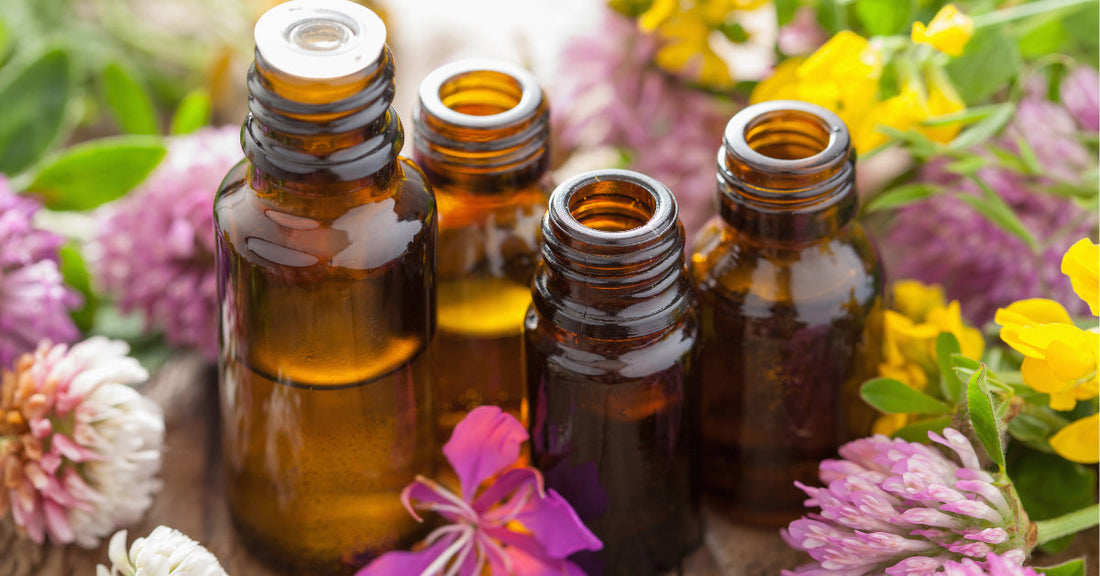Imagine a tiny bottle containing all the strength, energy and fragrance of an entire plant. From ancient Egypt to today's laboratories, essential oils have survived the centuries as precious treasures, veritable condensations of nature. These essences, often described as the DNA of plants, embody care, beauty and the sacred. More than just a cosmetic, they are the invisible thread linking skin, mind and emotions. Today, neurocosmetics is restoring these age-old elixirs to their central role, scientifically demonstrating what ancient civilizations already sensed: beauty is inseparable from inner harmony.
What is an essential oil?
An essential oil is a concentrated aromatic substance extracted from the flowers, leaves, bark, roots or resins of a plant. Its production is based on meticulous ancestral methods, principally steam distillation or cold pressing for citrus zests. Each drop captures the soul of the plant, its active molecules and therapeutic properties. This exceptional concentration explains how powerful these elixirs are, and why they need to be used with care. To illustrate this power, consider that a single drop of peppermint essential oil is equivalent to nearly sixty cups of peppermint tea.
The appeal of essential oils lies in their unique synergy of active molecules, capable of acting not only on the skin but also on the nervous system. They are more than just pleasant fragrances: they have a functional, vibratory and sensorial role to play. Some soothe inflammation, others stimulate cell regeneration, still others balance and protect. They act as veritable messengers of nature, transmitting the plant's vital energy directly to the skin and the senses.
The benefits of essential oils for the skin

For thousands of years, essential oils have been at the heart of beauty and skincare rituals. Their power is manifold, and each essence offers a specific action on the epidermis. Some oils purify and balance skin prone to imperfections. Tea tree essential oil for example, purifies acne-prone skin, while rose geranium regulates combination to oily skin, bringing harmony and balance. Other essences soothe and repair sensitive or irritated skin. true lavender promotes healing and soothes inflammation, while Roman chamomile relieves redness and skin irritation, providing comfort and softness.
Regeneration and anti-aging are also areas where essential oils excel. Immortelle, or Italian helichrysum is renowned for its ability to stimulate cell regeneration and reduce the appearance of scars and blemishes. Damask rose intensely moisturizes, tones and brightens the complexion, bringing an immediate, natural radiance. Certain oils, such as sandalwood or myrrh nourish and protect mature skin, promoting elasticity and vitality. Wild carrot revitalizes dull, tired complexions, bringing a subtle, luminous radiance. In this way, each essential oil acts as an ally, reminding us that authentic beauty results from a balance between skin care and inner well-being.
An ancestral story, when beauty and sacredness meet
Essential oils and aromatic resins have always been considered much more than mere cosmetics. They were a bridge between the human and the divine, between the care of the body and the elevation of the spirit. Ancient Egypt is without doubt the most emblematic example of this alliance between beauty and spirituality. Cleopatra, a timeless icon of seduction and refinement, used myrrh, rose and incense in her daily skincare rituals. Medical papyri dating back over four millennia describe cosmetic preparations based on cedar, jasmine and lotus, designed to nourish, protect and beautify the skin. Body beauty was intrinsically linked to spiritual purity, and the fragrances of essential oils were perceived as sacred messengers.
In Greece and Rome, scented baths and floral oil massages were an integral part of the art of living. Aromatic essences were considered elixirs of vitality, capable of balancing body and mind. Biblical texts also recall the sacred dimension of oils. Myrrh and frankincense are mentioned on numerous occasions, offered as royal gifts or used for sacred anointing. The Song of Songs evokes the fragrance of gardens and precious oils as a symbol of love and union, and anointing with oil was not just an aesthetic gesture, but an act of consecration and healing.
Through these traditions, it becomes clear that caring for the skin was never separate from caring for the soul. Beauty gestures were at once sensory, therapeutic and spiritual, inviting a holistic and conscious approach to the body.
Ancestral recipes that stand the test of time

Today, our ancient heritage provides us with timeless beauty recipes that continue to inspire modern natural skincare. Cleopatra's balm, for example, combines myrrh, rose and frankincense diluted in a vegetable oil such as sesame or moringa. This blend nourished and preserved the face's radiance, while providing a deep sense of well-being. Serum des reines d'Égypte combines jojoba oil with neroli, jasmine and frankincense to moisturize and sublimate the skin, offering both care and subtle fragrance.
Greek steam baths were rituals of sensory purification. Infusing rose petals with a few drops of lavender opened the pores, purified the skin and calmed the mind. In biblical traditions, anointing oil, composed of myrrh, frankincense and cedar mixed with olive oil, served both to protect the skin and to uplift the spirit. These ancestral preparations, rich in history and symbolism, have inspired modern natural skincare formulas, proving that the efficacy of essential oils goes far beyond the merely aesthetic.
Neurocosmetics: when skin talks to emotions
Neurocosmetics is a contemporary discipline that scientifically confirms what the ancients sensed: skin and mind are deeply connected. As our body's largest organ, the skin possesses a veritable sensory network and receptors that react to both external aggression and emotions. Stress or tension can lead to inflammation, redness or a dull complexion, while relaxation and emotional balance promote the skin's natural radiance and health.
Essential oils fit perfectly into this approach. Their aromatic molecules stimulate the limbic system, the seat of emotions, inducing calm, vitality and well-being. Fine lavender and Roman chamomile, for example, soothe sensitive skin while promoting emotional relaxation. Neroli and Damask rose regenerate the skin and support a subtle emotional balance. Rose geranium and wild carrot bring vitality and harmony, while myrrh and sandalwood nourish mature skin and invite inner anchoring. Bergamot and frankincense olibanum, in addition to their skin care properties, brighten the complexion and stimulate a sense of inner elevation.
This holistic approach proves that beauty is more than just appearance: it's the result of a balance between skin, senses and emotions. Neurocosmetics transforms each treatment into a veritable ritual of sensory and emotional well-being, where the skin becomes a mirror of the inner state.
Traditional recipes and sensory rituals
Today, these age-old practices inspire skincare routines that are both effective and sensorial. The anti-aging radiance serum, for example, combines rosehip oil with frankincense olibanum, Damask rose and wild carrot, and is applied to the face in the evening to stimulate skin regeneration and brighten the complexion. The sensory relaxing oil, with jojoba, fine lavender and Roman chamomile, is ideal for a facial or solar plexus massage, bringing relaxation and comfort.
In the morning, a mist of orange blossom hydrosol and a few drops of neroli awakens the skin and stimulates the senses. Steam baths with lavender or tea tree essences offer a moment of cutaneous and mental purification, helping to open pores, release impurities and create a sensation of freshness and lightness. Each gesture becomes a moment of connection with oneself, a holistic ritual that nourishes skin and soul.
These rituals are not just skincare techniques, they are an invitation to slow down, observe and listen to our skin and body. The sensory experience thus becomes a tool for self-awareness and well-being, a bridge between ancestral traditions and modern discoveries in neurocosmetics.
Everyday holistic beauty
Incorporating essential oils into a daily routine is much more than a cosmetic gesture: it's a conscious approach that links skin care, emotional balance and respect for nature. Each application is a moment of presence, each fragrance a reminder of plants and their vital energy. Essential oils make it possible to choose a personalized approach, adapted to each skin type, while limiting exposure to synthetic or aggressive products.
By respecting safety rules such as dilution in a vegetable oil, prior skin testing and avoidance of certain photosensitizing oils, they become powerful allies.
Make your own serums like a queen

Frankincense, the oil of kings
In the past, frankincense (Boswellia carterii) nicknamed "liquid gold", was reserved for sovereigns. Used in religious rituals, it was also highly appreciated for its anti-wrinkle and firming cosmetic benefits. Its soothing fragrance reduces stress, an aggravating factor in skin ageing, and its regenerating action stimulates the production of new cells.
Royal anti-aging recipe with frankincense
Ingredients:
- 30 ml vegetable oil of musk rose (rich in plant retinol)
- 5 drops of frankincense essential oil
- 3 drops of true lavender essential oil (soothing and healing)
- 2 drops essential oil of sandalwood (firming)
How to use :
Massage 2 to 3 drops onto face and neck in the evening, using upward movements.
Anti-aging serum with 5 precious essential oils
Ingredients:
- 30 ml of jojoba oil or prickly pear
- 3 drops of Damask rose essential oil (moisturizing and toning)
- 3 drops of jasmine essential oil (firming and softening)
- 3 drops of frankincense essential oil (regenerating)
- 2 drops of myrrh essential oil (anti-inflammatory and protective)
- 2 drops of neroli essential oil (anti-wrinkle and complexion radiance)
How to use :
Apply 3 to 4 drops morning and evening to slightly damp skin for better penetration. Expected effect: Radiant, velvety, plumped and visibly smoother skin.
(Caution: always do an allergy test 24 hours before use. Not recommended for pregnant and breast-feeding women, unless otherwise advised by a doctor).
About the author
Ophélie Thieblemont, a holistic aesthetician, worked as cosmetics and supplements manager at La Boite à Grains on the Plateau in 2024 and 2025
In-depth knowledge of :
- Cosmetology
- Medical Aesthetics
- Nutricosmetics (or cosmetofood)
- Aromatherapy
Discover all profiles from our experts!


